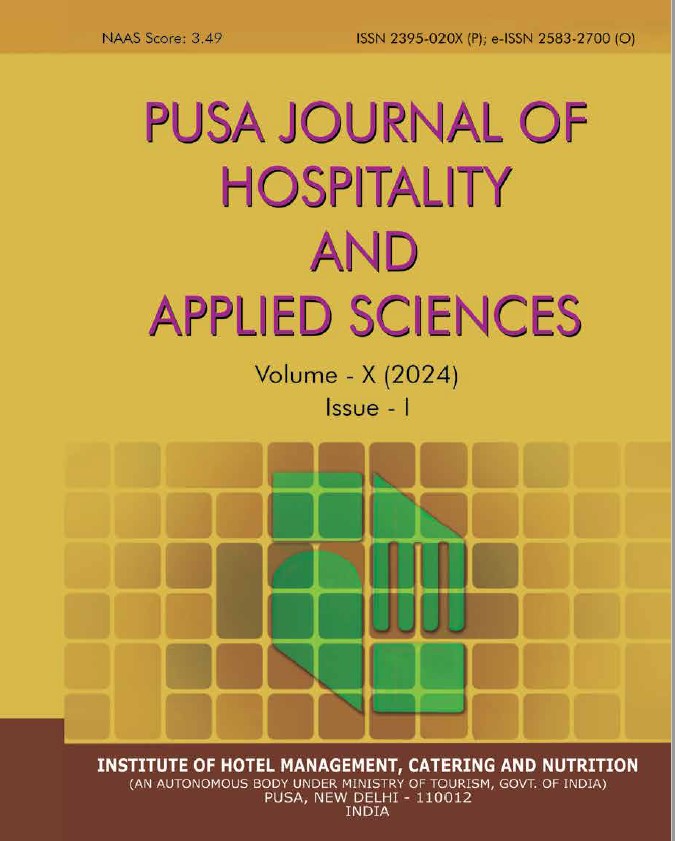To Assess And Compare The Operational And Financial Performance Of Stand-Alone Restaurants In Kolkata
Keywords:
Stand-alone Restaurants, Analysis, Comparison, Financial position, Performance, TrendsAbstract
Background: Nowadays, numerous restaurants have started operating with different and creative ideas. Apart from the chains and traditional brands of restaurants, the stand-alone variety is also emerging with modern concepts. The analysis and comparison of the performance of these stand-alone restaurants will provide insights into the market for such outlets. Objectives: The study assesses and compares the performance of stand-alone restaurants based on their operations and financial management. Methodology: The study has been carried out on two restaurants located in busy areas of Kolkata, West Bengal, India. The tools used for primary data collection are in-depth interviews with the restaurant owners, consolidated with the restaurant’s financial data. Analytical design was adopted and mathematical tool for data comparison was used. Results: It was observed that Restaurant Y performed better than Restaurant X, securing an average profit percent of 14.37% over 17 months. The other suffered an average loss of 10.28% during the same period. Patterns emerged indicating that revenue peaked during the months of September and October. Conclusion: Restaurant profiles, seating area, type of cuisine, value proposition alignment, cost structure, inventory, staff, and ticket price are important factors for a restaurant’s success. Customer sentiments impact the market, while Bengal’s Durga Puja is a driver for high revenue for such restaurants.
References
AIMS. (2002). Rise of the restaurant industry in India. Retrieved from https://theaims.ac.in/ resources/rise-of the-restaurant-industry-in-india.html. Accessed on 27:08:2019.
Andaleeb, S. S., & Conway, C. (2006). Customer satisfaction in the restaurant industry- an examination of the transaction specific model. Journal of Services Marketing, 20 (1), 3-11.
Banerjee, I. D. (2021). The Cultural Politics of Food, Taste, and Identity: A Global Perspective, Bloomsbury Publishing.
English, W. (1996) Restaurant attrition: a longitudinal analysis of restaurant failures, International Journal of Contemporary Hospitality Management, 8 (2).
Kim, W. G., Li, J. J., & Brymer, R. A., (2016). The impact of social media reviews on restaurant performance. International Journal of Hospitality Management. 55, 41- 51.
Kivela, J. J. (1997). Restaurant marketing selection and segmentation in Hong Kong, International Journal of Contemporary Hospitality Management. 9(3), 116-123.
Lee, T. J., Cho, H., & Ahn, T. H. (2012). Senior citizen satisfaction with restaurant service quality, Journal of Hospitality Marketing and Management, 2 (2), 215-226.
Melgarejo, A. M., Ramos, E. R., Moriones, E. R. & Tinnish, S. (2020) The Impact of Festival and Events in Chicago Hotel Industry, RevistaEspacios, 4 (25).
Namkung, Y., & Jang, S. C. (2008). Are highly satisfied restaurant customers really different, International Journal of Contemporary Hospitality Management, 20 (2), 142-155.
Pantelidis, I. S. (2010). Electronic meal experience: A content analysis of online restaurant comments, Cornell Hospitality Quarterly, 51 (4), 483-491.
Park, E., & Kim, W. H. (2020). The effect of inventory turnover on financial performance in the US restaurant industry: The moderating role of exposure to commodity price risk. Tourism Economics. https://journals.sagepub.com/doi/abs/10.1177/1354816620923860. doi:10.1177/1354816620923860.
Sen, K. C. (1998). The use of franchising as a growth strategy by U.S. restaurant franchisors, Journal of Consuner Marketing, 15 (4), 397-407.
Sharma, A. Banerjee, P. Yadav, R. S. & Dash, S. S. (2015) Emotional Labour in Interactive Service Roles in Indian Restaurants, Indian Journal of Industrial Relations, 51 (2). 338-350.
Singh, S. (2021) Are high rentals draining out restaurant business. Retrieved from https:// www.restaurantindia.in/article/are-high-rentals-draining-out-restaurant-business.13854. Accessed on 15:08:2021.
SMERGERS. (2013). Indian restaurant industry: what’s on your menu? Retrieved from https:// www.smergers.com/industry-watch/indian-restaurant-industry/. Accessed on 29:08:2019.
Timilsina, M. (2017) Impact of social media on restaurant business, A case study of restaurants based on Oulu region. https://core.ac.uk/download/pdf/84797241.pdf.




